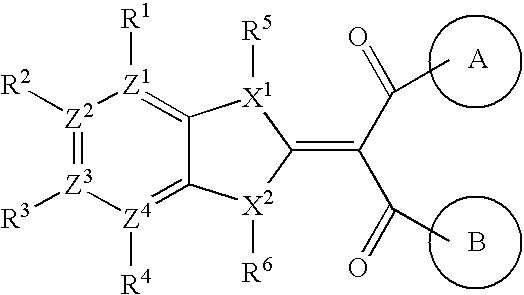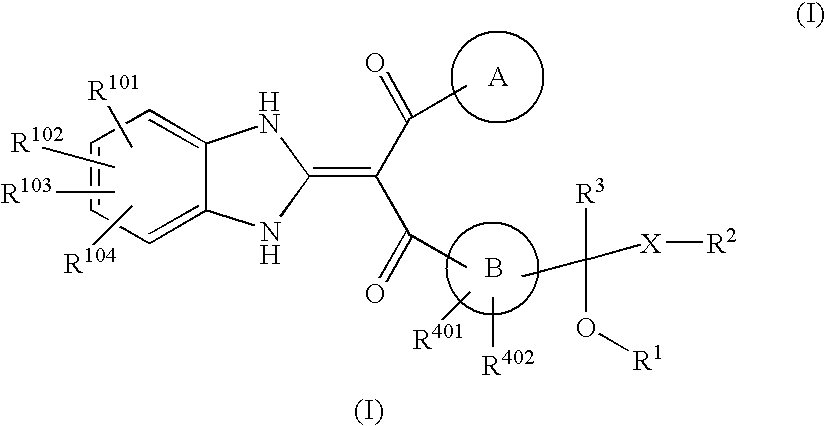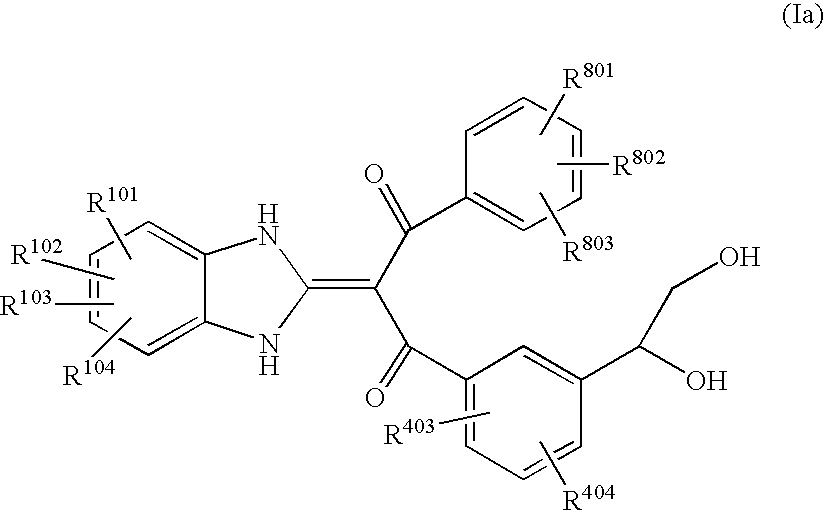Propane-1,3-Dione Derivative or Salt Thereof
a technology of propane and derivatives, applied in the field of new propane1, can solve the problems of lack of illustrative disclosure, and achieve the effects of strong gnrh receptor antagonism, strong drug effect, and excellent availability
- Summary
- Abstract
- Description
- Claims
- Application Information
AI Technical Summary
Benefits of technology
Problems solved by technology
Method used
Image
Examples
reference example 1-2
[0090]A 4.0 g portion of 2-methyl-1H-benzimidazole and 13.9 ml of TEA were dissolved in 40 ml of Diglyme, and 17.5 g of 2-chlorobenzoic acid chloride was added dropwise thereto. The reaction mixture was stirred at 100° C. for 3 hours. After cooling to room temperature, the reaction mixture was mixed with water, extracted with chloroform, dried with anhydrous sodium sulfate and then concentrated, thereby obtaining an orange oily substance. This was dissolved in 60 ml of methanol, mixed with 7.9 ml of morpholine and then heated under reflux for 3.5 hours. The reaction mixture was cooled to room temperature, mixed with water and then stirred for 1 hour. The thus formed precipitate was collected by filtration, washed with cool water and then dried to obtain 6.1 g (75%) of 1-(2-chlorophenyl)-2-(1,3-dihydro-2H-benzimidazol-2-ylidene)ethanone (Reference Example 1-2) as pale yellow powdery crystals. ES+: 271
[0091]The compounds shown in Table 5 and Table 6 were produced in the same manner.
TA...
reference example 2-1
[0092]A 3.8 g portion of oxalic acid chloride was gradually added dropwise to 30 ml of methylene chloride solution containing 1.54 g of 3-vinylbenzoic acid and a catalytically effective amount of DMF and stirred at room temperature for about 2 hours, and then an appropriate amount of Tol was poured into the mixture and evaporation was carried out under a reduced pressure, thereby preparing 3-vinylbenzoic acid chloride. This was dissolved in a small amount of Diglyme and gradually added dropwise to 5 ml of Diglyme solution containing 0.82 g of 1-(3,5-difluorophenyl)-2-(1,3-dihydro-2H-benzimidazol-2-ylidene)ethanone which had been separately prepare in advance and 1.4 ml of TEA, under heating at 70° C. After completion of the dropwise addition, this was risen to 100° C. and heated for about 25 minutes, mixed with 0.1 ml of purified water, and further risen to 175° C. and heated for about 25 minutes. This was mixed with sodium bicarbonate aqueous solution, extracted several times with ...
reference example 3
[0094]A 4.96 g portion of ethyl orthoacetate dissolved in 10 ml of ethanol was added to 50 ml of ethanol solution containing 4.68 g of 4-chloro-5-fluorobenzene-1,2-diamine and heated under reflux for 4 hours. After concentration of the reaction liquid, the thus formed residue was purified by a silica gel column chromatography to obtain 2.10 g (39%) of 5-chloro-6-fluoro-2-methyl-1H-benzimidazole from a chloroform-methanol (10:1) eluate. ES+: 185
PUM
| Property | Measurement | Unit |
|---|---|---|
| temperature | aaaaa | aaaaa |
| temperature | aaaaa | aaaaa |
| temperature | aaaaa | aaaaa |
Abstract
Description
Claims
Application Information
 Login to View More
Login to View More - R&D
- Intellectual Property
- Life Sciences
- Materials
- Tech Scout
- Unparalleled Data Quality
- Higher Quality Content
- 60% Fewer Hallucinations
Browse by: Latest US Patents, China's latest patents, Technical Efficacy Thesaurus, Application Domain, Technology Topic, Popular Technical Reports.
© 2025 PatSnap. All rights reserved.Legal|Privacy policy|Modern Slavery Act Transparency Statement|Sitemap|About US| Contact US: help@patsnap.com



